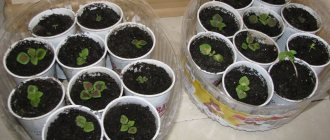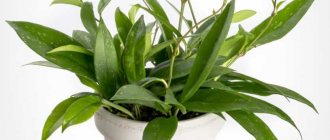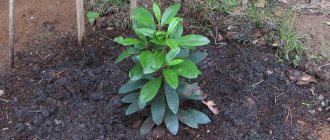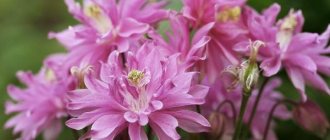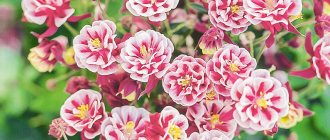Author: Elena N. https://floristics.info/ru/index.php?option=com_contact&view=contact&id=19 Category: Garden plants Published: February 04, 2019Last edits: January 20, 2021
- Growing on a windowsill
- Hybrid coleus (Coleus x hybridus)
Coleus, with its bright, variegated leaves, resembles both croton and begonia. This is a charming and not at all capricious plant that requires minimal care. Some may think that coleus is simple, but this is a misleading impression: the plant has a strong character and powerful energy potential. Interesting fact: on the surface of coleus leaves there are tubercles that work like lenses: by reflecting light, they make the color of the leaf plates brighter and more saturated.
You can learn from our article how to:
- grow coleus from seeds;
- care for the plant in the garden and at home;
- propagate coleus and protect it from diseases and pests.
Planting and caring for coleus
- Flowering: decorative deciduous plant.
- Planting: sowing seedlings - at the end of March, planting in the ground - from the second half of May.
- Lighting: bright sunlight until noon, then partial shade.
- Temperature: in summer – 18-20 ˚C, in winter – not lower than 12 ˚C.
- Watering: abundant and frequent.
- Air humidity: high, frequent spraying is necessary, especially in hot weather.
- Feeding: in spring and summer – once a week, in winter – once a month with complex mineral fertilizer.
- Pinching: during the period of active growth - regular.
- Pruning: after the dormant period before the start of the growing season.
- Dormant period: winter.
- Replanting: once every 3-4 years.
- Reproduction: seeds, cuttings.
- Pests: aphids, whiteflies, mealybugs and spider mites.
- Diseases: root and stem rot.
Read more about growing coleus below.
flowers (lat. Coleus) belong to the genus of the Lamiaceae or Lamiaceae family, numbering about 150 species. The name of the plant is derived from the Greek word “kleos”, meaning “case”. The homeland of the coleus plant is the tropical forests of Asia and Africa. Among hobby gardeners, the coleus flower is known as the "poor man's croton" because its variegated leaves resemble croton foliage, only they look simpler, and the "garbage plant" - well, that's because many of them have not seen the new varieties of coleus that allow it to compete today not only with croton, but also with other expensive popular plants. The main advantage of coleus, in addition to its variegated beauty, is its ease of care.
Plant diseases and pests
Coleus is considered an unpretentious plant to care for, but some rules must be followed. From improper care, the plant can be weakened, lose its decorative appearance, and pests can settle on it. Most often, indoor plants suffer.
The main and most common reasons may be:
- the stem at the bottom has rotted, this can happen with stagnant moisture or acidified soil;
- the leaves begin to dry out at the tips - insufficient watering, dry air in the room, the plant is not sprayed regularly;
- the leaves on the nettle began to fall off - drafts and the plant was cold;
- spots on the leaves – sunburn;
- the leaves become dull - there is not enough light or they have not been fed for a long time;
- flower growth has slowed down - there is not enough nutrition in the soil.
All this will lead in the future to the colonization of weakened bushes by pests. They will show their presence by deformation, discoloration and drying of the leaves.
Botanical description
Coleus stems are ribbed, tetrahedral, woody at the base. The leaves are pubescent, heart-shaped, opposite, jagged, sometimes small, but in some species they reach a length of 15 cm. The stems and leaves of natural plant species resemble nettles, which is why coleus is popularly nicknamed “nettle”. The color of the leaves is all possible combinations of green, burgundy, yellow, and red. Small blue or purple flowers are collected in spike-shaped inflorescences.
- Features of caring for the Decembrist
The flowering of decorative-leaved coleus does not cause any particular interest among gardeners - there is nothing remarkable in its flowers. These types of coleus are grown for their amazing leaves, although there are also beautifully flowering species and varieties of coleus.
Growing coleus in the garden
Sowing seeds
The coleus plant is popular not only because it is beautiful, but also because it is easy to care for. And most importantly, the houseplant coleus can be grown in gardens with no less success. Coleus reproduces well by seed, especially since excellent English and Dutch variety mixtures can easily be found on sale today. It is best to sow coleus at the end of March. You can do this at other times of the year, but then you will have to provide additional artificial lighting for the seedlings in winter or autumn.
You will need fertile but light soil; it is best to use a flat box as a container. Coleus seeds are laid out on the surface of the soil, not in a heap, sprayed with a spray bottle, without covering them, lightly “salted” with sand, covered with glass and placed in a warm, dark place, subsequently maintaining the soil in the greenhouse in a slightly damp state.
The germination rate of purchased seeds is very high, and you can expect that every seed will germinate. This will happen faster than you expect - already on the seventh to tenth day, and as soon as the first shoots appear, remove the glass and move the greenhouse to a bright eastern or western window, protecting the sprouts from direct sunlight. The temperature should now be 17-19 ºC.
In the photo: Coleus / Coleus Honey Crisp
Growing seedlings
At the age of 3-4 weeks, when the seedlings have the first pair of true leaves, they need to be transplanted into special cassettes so that they can develop a strong root system that can not be injured when transplanted into the ground. And when the young coleus are 5-6 weeks old, transplant each into a four-hundred-gram glass and pinch to stimulate tillering.
Planting coleus
Coleus are planted in garden soil only after the final onset of warm days. Choose a brightly lit area for them, but slightly shaded at midday and protected from the wind, dig holes, add fertile water- and breathable substrate into them, and plant coleus bushes from cups in the holes. Planting coleus does not require any special knowledge or skills.
- Epipremnum at home: care and types
If you grow it as an annual, even more so. And even if you plan to make a perennial out of it, then, firstly, you are unlikely to succeed - in two or three years you will still have to grow a new coleus from seeds or cuttings, and secondly, you will have to winter it dig it up and bring it into the house so that it can be planted in the ground again in the spring. Therefore, just plant coleus bushes at a short distance from each other and do not forget to water them after planting.
In the photo: Beautiful coleus leaves
Coleus care
Caring for coleus primarily involves abundant watering, especially in dry summer conditions. It is advisable to water with settled water, for which it is a good idea to have a barrel or tub in the garden in which tap water will settle or rainwater will accumulate. Loosen the soil after watering and remove weeds. Two or three times a summer, lightly trim your handsome man to make him bushier.
In the photo: Coleus in open ground
During the period of active growth, fertilizing should be done weekly with fertilizers with a high nitrogen content in order to stimulate leaf growth and not provoke early flowering. When flowering does occur, immediately remove the flower stalks so that they do not take away the strength of the coleus. That's all the wisdom. As you can see, growing coleus in the garden is not difficult.
Flower propagation
Seeds
We propagate plants by seeds and cuttings. The last method is the most popular. It allows you to quickly get large, bushy plants. We sow coleus seeds in February in small containers with a nutrient substrate, sprinkling them with sand on top. At an average temperature of about 20 degrees, we get seedlings in a couple of weeks. We plant flower seedlings in special peat pots with a nutritious soil mixture of peat, leaf soil, turf and sand (1:1:1:1), regularly water and feed them until the moment they are planted in open ground. We cut cuttings for plant propagation in February-March, planting them in boxes with sand or rooting them in water. After 7-14 days, roots appear, after which we plant the cuttings in peat pots, pinching the tops of the long cuttings.
Cuttings
We plant seedlings or rooted flower cuttings in open ground when the average daily air temperature begins to warm up to 16-18 degrees. We place young plants in the garden flower bed, taking into account the fact that they grow quickly. They need enough space for vigorous growth. We provide young plants with timely watering, loosening the soil, and regular fertilizing. Coleus are notable for their rapid development. Over the course of 2.5-3 months, from the seedling we obtain a large, highly branched plant with large leaves. Specimens obtained from cuttings grow even faster. To create beautiful bushy flower specimens, we pinch out its growing shoots.
Coleus at home
Growing on a windowsill
Indoor coleus, like garden coleus, is propagated by seeds and cuttings. Propagation of indoor coleus by seeds occurs in the same way as garden ones: the seeds are sown, and when shoots appear, they are planted into cassettes, and during the second planting the seedling is planted in a permanent pot. Everything is simple, and almost the same as with seed propagation of garden coleus. And now we will tell you how to grow coleus from cuttings.
In the photo: Coleus / Coleus Henna
Growing coleus from cuttings
When you cut the coleus, you are left with cuttings that you can use for cuttings. The stalk should be about 10 cm long. You need to remove the leaves from its lower part and stick it into damp soil or sand, cover it with polyethylene or a plastic bottle and keep it in the shade at a temperature of 18-20 ºC. The roots will appear in 8-10 days, and you can immediately transplant the cutting to a permanent place. This type of propagation is as simple as it is reliable.
Home care
There are no difficulties in this matter either: abundant watering with settled soft water at room temperature, especially in the spring and summer, is the most important point. Indoor coleus also needs to be fertilized weekly in spring and summer with complex fertilizer at half the dose specified by the manufacturer. In winter, fertilize coleus once a month.
In the photo: Coleus / Coleus Magilla Perilla
In the warm season, regular spraying of the plant is desirable, but not in the sun, but in the shade, and in winter, in a heated room, it is better to maintain air humidity in another way - keeping a pot of coleus on a tray with wet expanded clay. Be sure to remove the buds that appear if your coleus is not an ornamental flowering plant, so that the development of flowers does not take away the strength of the plant.
- Areca at home: care and types
During the period of active growth, coleus will have to be pinched more than once, stimulating branching, and after rest, before the new season, you need to cut off all shoots at a height of 5-7 cm in order to rejuvenate the plant. Experienced flower growers, just in case, plant cuttings obtained during pruning for rooting - in case last year’s coleus does not live up to expectations and still loses its decorative effect.
In the photo: Growing coleus in a flower bed
Diseases and their treatment
If you pinch or trim a young plant at the wrong time, its shoots can become very elongated. The same thing happens if your coleus is old or if the young plant is dark. If the light is too bright, the color of the leaves becomes pale and discolored. If there is insufficient watering, the plant loses its leaves; if it is over-watered, the leaves will also fall off.
Among the pests that are dangerous to coleus are aphids, spider mites and whiteflies. Aphids feed on plant sap, causing damaged leaves to turn yellow and shrink, and are carriers of diseases. It’s easy to combat: you need to treat the above-ground parts of indoor coleus with a soap solution, and if some of the pests survive, then the treatment needs to be repeated after a week. Before manipulating, do not forget to cover the soil in the pot with film so that soap does not get into it.
With garden coleus, such a “detailed” method is too labor-intensive, so you will have to use insecticides. Actellik and Fitoverm have proven themselves to be good in the fight against aphids. You cannot use soap to remove ticks, so we recommend Oberon, Apollo, Agravertin or Akarin. Whiteflies can be destroyed with the same drugs as aphids: Actellik, Aktara, Oberon, etc.
In the photo: Coleus tricolor / Coleus Tricolor
But the use of insecticides does not add health to the plants, so as a preventive measure, follow simple rules for caring for coleus, and such troubles as diseases and pests will bypass you.
Landing
When planning to plant a plant outside, you need to choose a suitable site. If the location is well lit, then it will be able to grow healthy, vibrant foliage. In addition to these indicators, there are some other important points:
- Varieties with white or red leaves need direct sunlight.
- Coleus with green leaf blades, on the contrary, begins to deteriorate from bright light, causing burns. Therefore, during active sunny times, he needs to provide shade. It is recommended to immediately place such varieties in a shaded area.
The flower will be able to develop well and have a beautiful clear pattern on the foliage if it receives enough nutrients from the ground. Gardeners recommend using a mixture that contains chernozem (4 parts), pine needles (2 parts), cow manure (2 parts), sand (1 part).
Before planting, the soil should be properly prepared. To do this, it is heated and sifted. To grow coleus, you can use seedlings or seeds. But it is worth considering that you will have to wait a long time to get seedlings from seeds. And seedlings allow you to grow an ornamental plant on your site in a short time.
Work on sowing seeds is carried out after the 15th of March. The first shoots begin to appear already after. With the appearance of sprouts, the shelter is removed and the container is moved to a place with good lighting, but without direct sunlight. The appropriate side would be west or east. The recommended temperature level is 17-19°C.
When the ground has warmed up well, seedlings can be planted in it. As a rule, such work is carried out with the arrival of June. If before this coleus grew on a windowsill, then it has all the necessary qualities that are necessary for a painless transplant outside.
The holes are dug while maintaining a distance from neighboring seedlings. Seedlings are placed in them, and then the free space is filled with soil.
Coleus in winter
As already mentioned, garden coleus is most often grown as an annual. If you are sorry to part with it, dig up a bush, replant it in a pot, bring it into the house and care for it like a houseplant: gradually reduce watering towards winter, and fertilize once a month. You should also care for indoor coleus. In winter, in addition to reducing watering, the temperature of the coleus should also be reduced to 8-15 ºC.
In the photo: Coleus flower / Coleus Beaute de Lyon
Use in landscape design
Nettles have some extremely unsightly varieties. Therefore, the most beautiful varieties with brightly colored leaves are used for flower beds.
Sometimes the flowerbed lacks brightness. Coleus will correct the situation when the dominant plants have not yet bloomed or have already faded. The lawn with cheerful islands of nettles is very impressive.
Coleus is versatile. Pairs well with conifers, annuals and perennials. It will keep company with ageratum, verbena, mantle, irises, daylilies, chamomile, ivy, etc. Nettles planted in a row look beautiful as a border decoration.
If you plant different varieties of nettles in the form of different geometric shapes, you get living pictures!
You can not transplant indoor specimens into the flower garden, but leave them in pots. But you will have to water them often, on hot days even 2 times a day, since a container not buried in the ground heats up quickly.
As you can see, coleus will not cause much trouble. It grows quickly and is ideal for busy gardeners. You can safely grow it in your dacha, even if you can’t go there every week. Simple propagation methods make it possible to create beautiful flower beds with minimal investment.
Types and varieties
Hybrid coleus (Coleus x hybridus)
In indoor floriculture, as a rule, hybrid coleus - the plant is not very large and completely unpretentious. The height of hybrid coleus reaches one meter, the stem has a square cross-section. The leaves are elongated-oval with serrated edges. Depending on whether the plant is in the shade or in the sun, the color of the leaves may be green or burgundy, respectively.
Pictured: Purple coleus
Coleus rehneltianus
Coleus Renelta, originally from Sri Lanka, is grown as an ornamental hanging plant The leaves of this species are opposite, on long petioles, broadly heart-shaped with wavy edges, decorated with multi-colored veins - yellow, purple, brown, red...
In the photo: Coleus bush
Coleus blumeii
But the most popular among gardeners is Coleus Blume and its many varieties. The homeland of Coleus Blume is Southeast Asia. It is a subshrub with woody shoots up to 80 cm high at the base. The best varieties: Black dragon - brown-purple leaves ribbed along the edges with red veins; hybrids of the Wizzard series - coleus Wizzard Golden with yellow-light green leaves, Wizzard Evening Dawn with fiery red leaves and a narrow greenish border, Wizzard Jade with a wide green border along white leaves.
Among the huge variety of coleus varieties, you are sure to find several species with which you will be happy to decorate your garden and your home.
